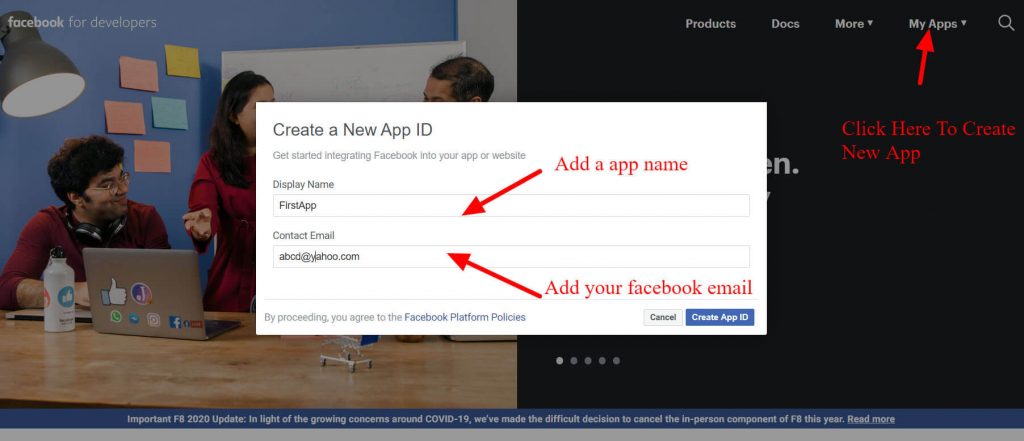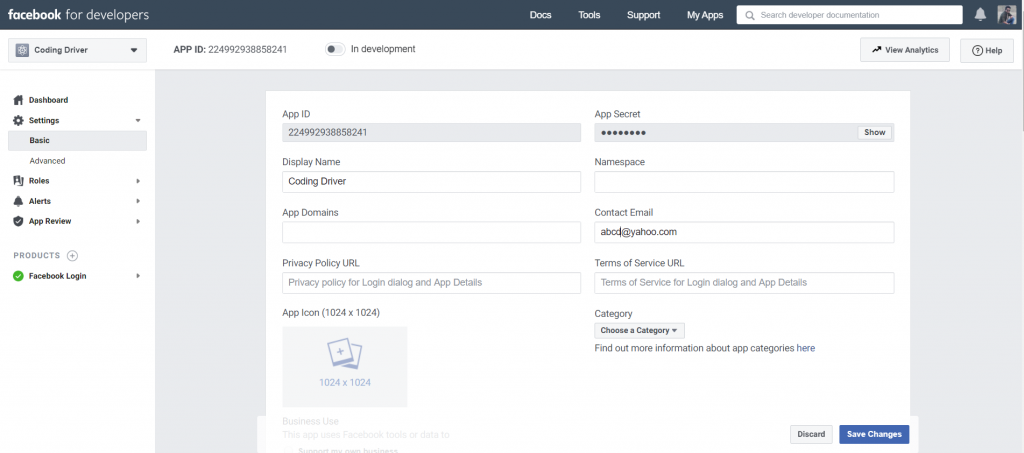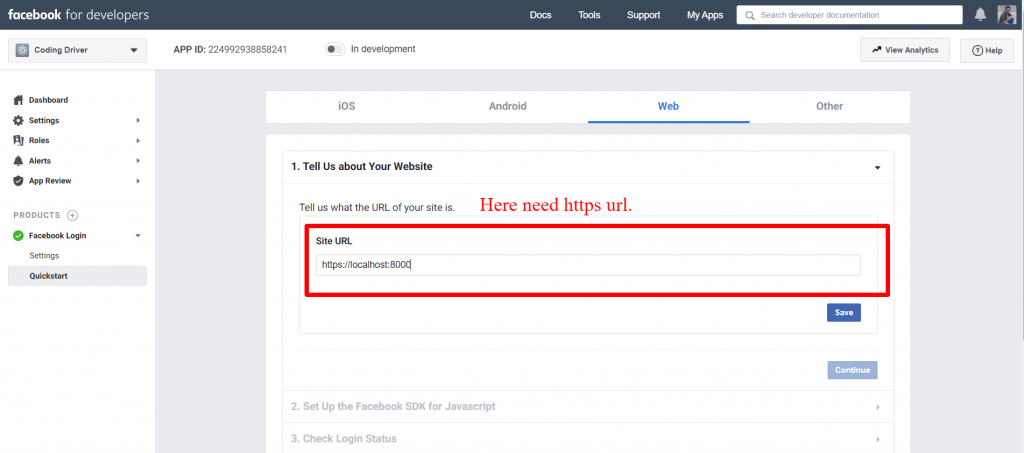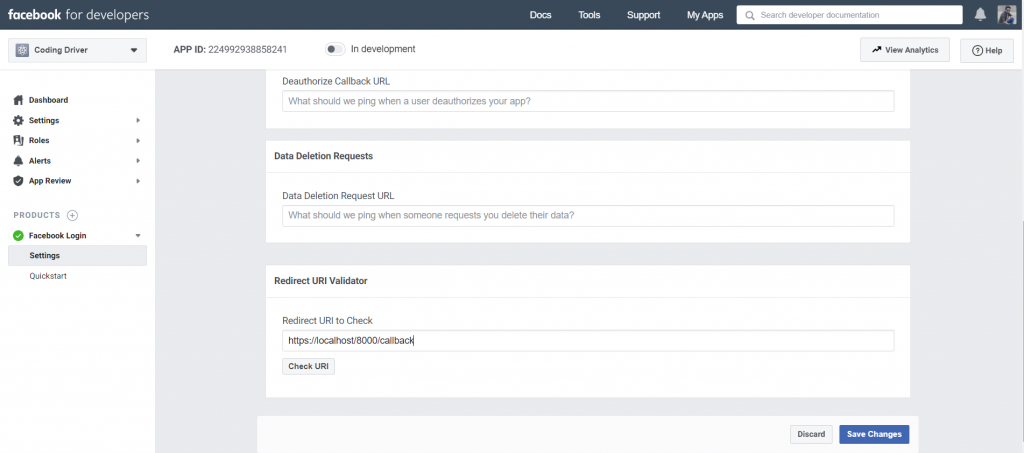Login with Laravel 8 and Socialite, Facebook
Step 1: Install Laravel 8
step: Install UI
Note:
composer require laravel/ui
php artisan ui vue --auth
First, install a new Laravel app just running the below command in your terminal.
composer create-project --prefer-dist laravel/laravel laravel_login_facebookStep 2: Update Your Database Credentials
After that update your database credentials in your .env file which is located in your project root.
DB_CONNECTION=mysql
DB_HOST=127.0.0.1
DB_PORT=3306
DB_DATABASE=laravel_custom_auth
DB_USERNAME=root
DB_PASSWORD=#your database passwordFACEBOOK_CLIENT_ID="your facebook id" FACEBOOK_CLIENT_SECRET="your secret"
Step 3: Create Laravel Authentication
Now the basic authentication we need to run the auth command of Laravel just running the below command.
php artisan make:authAfter running this you check-in web.php have added auth routes automatically. These routes work Laravel inbuilt function.
Step 4: Download Socialite Package
The Laravel socialite package makes authentification with traditional social networks simple. So download the socialite package just running the below command.
composer require laravel/socialitecomposer self-update --2now open the config\services.php and add the below code on it.
config\services.php
'facebook' => [
'client_id' => env('FACEBOOK_CLIENT_ID'),
'client_secret' => env('FACEBOOK_CLIENT_SECRET'),
'redirect' => 'http://localhost/Login_Socialite/public/login/facebook/callback',
],Step 5: Get secrets from Facebook
Here we get CLIENT ID and CLIENT SECRET for the Facebook login button in Laravel based project, So we need to go https://developers.facebook.com/ and create an app. Create an app in the config/service.php file just like below.
1) First Go to My Apps and click create the new app you get a popup just like below. add your new app name and your Facebook email id on it.

2) Next, go to Settings -> Basic, copy your App Id and App Secret, and add in your .env file we have displayed below. Follow the next step before going to the Facebook login step.

3) Now click on the ‘+’ button beside ‘PRODUCTS’, select quickstart you got a window there your see four option (‘ios’, ‘android’, ‘web’, ‘other’) select web option then your see below the image where you need to add your website URL: https://localhost:8000 and click on ‘Save’ as shown below…

4) Then go to Facebook Login -> Settings, scroll down to ‘Valid OAuth Redirect URL’ and add your callback /redirect URL: https://localhost:8000/callback and Save changes as illustrated below…

Now our App settings are done, copy your client id, client secret, and predict you're and save in .env file.
Step 6: Make Migration
public function up()
{
Schema::create('users', function (Blueprint $table) {
$table->id();
$table->string('name');
$table->string('email')->unique();
$table->string('provider_id')->nullable();
$table->text('avatar')->nullable();
$table->timestamp('email_verified_at')->nullable();
$table->string('password')->nullable();
$table->rememberToken();
$table->timestamps();
});
}After adding the migration file now run the migrate command.
php artisan migrateStep 7: Add Routes
In this step we create routes for Facebook login, add two routes in your web.php file.
app/routes/web.php
<?php
use Illuminate\Support\Facades\Route;
/*
|--------------------------------------------------------------------------
| Web Routes
|--------------------------------------------------------------------------
|
| Here is where you can register web routes for your application. These
| routes are loaded by the RouteServiceProvider within a group which
| contains the "web" middleware group. Now create something great!
|
*/
Route::get('/', function () {
return view('auth.login');
});
Auth::routes();
Route::get('/home', [App\Http\Controllers\HomeController::class, 'index'])->name('home');
// Facebook login
Route::get('login/facebook', [App\Http\Controllers\Auth\LoginController::class, 'redirectToFacebook'])->name('login.facebook');
Route::get('login/facebook/callback', [App\Http\Controllers\Auth\LoginController::class, 'handleFacebookCallback']);
// -----------------------------forget password ------------------------------
Route::get('forget-password', 'App\Http\Controllers\Auth\ForgotPasswordController@getEmail')->name('forget-password');
Route::post('forget-password', 'App\Http\Controllers\Auth\ForgotPasswordController@postEmail')->name('forget-password');
Route::get('reset-password/{token}', 'App\Http\Controllers\Auth\ResetPasswordController@getPassword');
Route::post('reset-password', 'App\Http\Controllers\Auth\ResetPasswordController@updatePassword');Step 8: Create LoginController
php artisan make:controller LoginController<?php
namespace App\Http\Controllers\Auth;
use App\Http\Controllers\Controller;
use App\Models\User;
use App\Providers\RouteServiceProvider;
use Illuminate\Foundation\Auth\AuthenticatesUsers;
use Illuminate\Support\Facades\Auth;
use Laravel\Socialite\Facades\Socialite;
class LoginController extends Controller
{
/*
|--------------------------------------------------------------------------
| Login Controller
|--------------------------------------------------------------------------
|
| This controller handles authenticating users for the application and
| redirecting them to your home screen. The controller uses a trait
| to conveniently provide its functionality to your applications.
|
*/
use AuthenticatesUsers;
/**
* Where to redirect users after login.
*
* @var string
*/
protected $redirectTo = RouteServiceProvider::HOME;
/**
* Create a new controller instance.
*
* @return void
*/
public function __construct()
{
$this->middleware('guest')->except('logout');
}
// Facebook login
public function redirectToFacebook()
{
return Socialite::driver('facebook')->redirect();
}
// Facebook callback
public function handleFacebookCallback()
{
$user = Socialite::driver('facebook')->user();
$this->_registerOrLoginUser($user);
// Return home after login
return redirect()->route('home');
}
protected function _registerOrLoginUser($data)
{
$user = User::where('email', '=', $data->email)->first();
if (!$user) {
$user = new User();
$user->name = $data->name;
$user->email = $data->email;
$user->provider_id = $data->id;
$user->avatar = $data->avatar;
$user->save();
}
Auth::login($user);
}
}
<?php
namespace App\Http\Controllers\Auth;
use App\Http\Controllers\Controller;
use App\Models\User;
use App\Providers\RouteServiceProvider;
use Illuminate\Foundation\Auth\AuthenticatesUsers;
use Illuminate\Support\Facades\Auth;
use Laravel\Socialite\Facades\Socialite;
class LoginController extends Controller
{
/*
|--------------------------------------------------------------------------
| Login Controller
|--------------------------------------------------------------------------
|
| This controller handles authenticating users for the application and
| redirecting them to your home screen. The controller uses a trait
| to conveniently provide its functionality to your applications.
|
*/
use AuthenticatesUsers;
/**
* Where to redirect users after login.
*
* @var string
*/
protected $redirectTo = RouteServiceProvider::HOME;
/**
* Create a new controller instance.
*
* @return void
*/
public function __construct()
{
$this->middleware('guest')->except('logout');
}
// Facebook login
public function redirectToFacebook()
{
return Socialite::driver('facebook')->redirect();
}
// Facebook callback
public function handleFacebookCallback()
{
$user = Socialite::driver('facebook')->user();
$this->_registerOrLoginUser($user);
// Return home after login
return redirect()->route('home');
}
protected function _registerOrLoginUser($data)
{
$user = User::where('email', '=', $data->email)->first();
if (!$user) {
$user = new User();
$user->name = $data->name;
$user->email = $data->email;
$user->provider_id = $data->id;
$user->avatar = $data->avatar;
$user->save();
}
Auth::login($user);
}
}Step 9: Add Button in Login Page
Add the below code in your login.blade.php file.
Resources/Views/passwords/Auth/login.blade.php
Add the below code in your login.blade.php file.
Resources/Views/passwords/Auth/login.blade.php
@extends('layouts.app') @section('content') <div class="login-form"> <form method="POST" action="{{ route('login') }}"> @csrf <div class="text-center"> <a href="" aria-label="Space"> <img class="mb-3 logo-image" src="{{URL::to('assets/images/logo_log.png')}}" alt="Logo" width="60" height="60"> </a> </div> <div class="text-center mb-4"> <h1 class="h3 mb-0">Please sign in</h1> <p>Signin to manage your account.</p> </div> @if(session()->has('error')) <div class="alert alert-danger"> {{ session()->get('error') }} </div> @endif <div class="js-form-message mb-3"> <div class="js-focus-state input-group form"> <div class="input-group-prepend form__prepend"> <span class="input-group-text form__text"> <i class="fa fa-envelope form__text-inner"></i> </span> </div> <input type="email" class="form-control form__input @error('email') is-invalid @enderror" name="email" value="{{ old('email') }}" placeholder="Email" autocomplete="email"> @error('email') <span class="invalid-feedback" role="alert"> <strong>{{ $message }}</strong> </span> @enderror </div> </div> <div class="form-group"> <div class="input-group"> <div class="input-group-prepend"> <span class="input-group-text"> <i class="fa fa-lock"></i> </span> </div> <input type="password" class="form-control @error('password') is-invalid @enderror" name="password" placeholder="Password" autocomplete="new-password"> @error('password') <span class="invalid-feedback" role="alert"> <strong>{{ $message }}</strong> </span> @enderror </div> </div> <div class="row mb-3"> <div class="col-6"> <!-- Checkbox --> <div class="custom-control custom-checkbox d-flex align-items-center text-muted"> <input class="custom-control-input"type="checkbox" name="remember" id="remember" {{ old('remember') ? 'checked' : '' }}> <label class="custom-control-label" for="remember"> Remember Me </label> </div> <!-- End Checkbox --> </div> </div> <div class="form-group mb-3"> <button type="submit" class="btn btn-primary login-btn btn-block">Signup</button> </div> <div class="text-center mb-3"> <p class="text-muted">Have an account? <a href="{{route('register')}}">Signin</a></p> </div> <div class="or-seperator"><i>OR</i></div> <div class="row mx-gutters-2 mb-4"> <div class="col-sm-12"> <a href="{{ route('login.facebook') }}"> <button type="button" class="btn btn-block btn-facebook"> <i class="fa fa-facebook mr-2"></i>Facebook </button> </a> </div> </div> <p class="small text-center text-muted mb-0">All rights reserved. © Space. 2021 soengsouy.com.</p> </form> </div> @endsection
Step 9: Run Development Server
After successfully update all run the development server just adding the below command in the terminal.
php artisan serveAfter this go to the browser and check using the login page.
http://localhost/laravel_login_facebook/public/